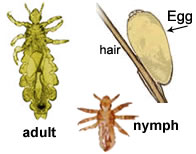- Elementary Schools
- Head Lice Facts
Popular Links
Health Services
Page Navigation
-
Dear Parent or Guardian,
At this age, it is very important that you understand the facts about head lice.Head lice checks are very time-consuming and tedious and often cannot be accomplished in one setting.Here is some information to help you prevent head lice in your child.A few things to consider at home:
- Please notify the school nurse about head lice
- Checking all household members and other close contacts at least once a week.
- Use a large magnifying glass and a bright light to help you see.
- Itching, especially around the ears and back of the neck is the most common sign of head lice.
- If there is evidence of active infestation, all members must be treated at the same time.
- After treatment, it is important to comb out all the nits with a special nit comb for several days.
- Students cannot return to school until they have been treated. Remember to retreat in 7-10 days.
- There are new, safer prescription treatments available.
- Talk to your doctor or pharmacist to get appropriate care.
- Resistance to some head lice treatments have been reported.
- If your child has live lice after two treatments, contact your doctor for a different form of therapy.
- There is no scientific evidence that home remedies are effective treatments.
- Bed linens, blankets, and recently worn clothes must be washed in very hot water.
- Vacuum furniture, mattresses, pillows, and carpets.
- Remind your child to keep their head from touching others when playing, hugging, whispering, and any other way their head may get close to someone else.
There are three stages of lice:- From EGG to NYMPH (small adult) to LOUSE (fully grown adult).
- Lice are wingless insects that live on the human scalp and feed on human blood, so they don't live long off the head.
- They cannot fly or jump. They are crawling creatures.
- Live head lice that fall on a desk or floor at school will not be alive the next day.
- The eggs (or nits) are tiny teardrop shaped and are found near the scalp.
- Nits cannot be caught by another person. A nit is only an egg.
- Unlike dandruff, they are yellowish-brown in color and difficult to remove.
 Reasons for the re-infestation of head lice:
Reasons for the re-infestation of head lice:- Not using enough head lice product
- Not following up with a second application
- Not removing all nits
- Not adequately cleaning the home environment
Head lice are spread by direct head-to-head contact with another person who has them, for example, during play, slumber parties, sports activities, family parties, or camp.

